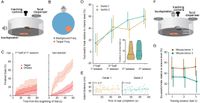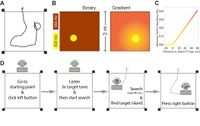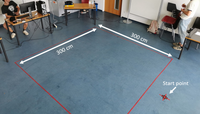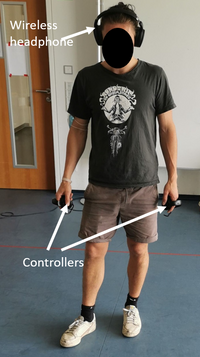Projects in the pecka lab
How do we hear out individual talkers from a crowd or a car in heavy traffic? A central goal of the lab is to reveal the neuronal coding and circuits underlying selective listening to a specific sound source out of many, as typically performed during auditory scene analysis (ASA).
Despite decades of research, a functional understanding of the neuronal mechanisms of ASA remains elusive. Most studies had focused on the instant processing of simple sounds in passive settings. During realistic ASA, however, self-motion continuously modulates sensory input.
Consequently, we are utilizing SIT (Ferreiro, Amaro et al., 2020, see below) in combination with chronic multi-electrode recordings in freely navigating gerbils, to investigate the neural computations of ASA.Based on the recent finding that the task-specific identity of sound-sources alteres the spatial preference of A1 neurons (Amaro et al., 2021), the lab is currently working on several projects:
Current projects
Studying goal-oriented behavior with SIT
A central function of sensory systems is the gathering of information about dynamic interactions with the environment during active exploration. To determine whether modulation of a sensory cue was externally caused or a result of self-motion is fundamental to perceptual invariance and requires the continuous update of sensory processing about recent movements. This process is highly context-dependent and crucial for perceptual performances such as decision-making and sensory object formation. Yet despite its fundamental ecological role, active sensing is rarely incorporated in perceptual or neurophysiological investigations of sensory processing in animals. We developed the Sensory Island Task (SIT), a new freely moving search paradigm to study sensory processing and perception.In SIT, animals explore an open-field arena to find a sensory target relying solely on changes in the presented stimulus, which is controlled by closed-loop position tracking in real-time. Within a few sessions, animals are trained via positive reinforcement to search for a particular area in the arena (“target island”), which triggers the presentation of the target stimulus. The location of the target island is randomized across trials, making the modulated stimulus feature the only informative cue for task completion. Animals report detection of the target stimulus by remaining within the island for a defined time (“sit-time”). Multiple “non-target” islands can be incorporated to test psychometric discrimination and identification performance. We exemplify the suitability of SIT for rodents (Mongolian gerbil, Meriones unguiculatus) and small primates (mouse lemur, Microcebus murinus) and for studying various sensory perceptual performances (auditory frequency discrimination, sound source localization, visual orientation discrimination). Furthermore, we show that pairing SIT with chronic electrophysiological recordings allows revealing neuronal signatures of sensory processing under ecologically relevant conditions during goal-oriented behavior. In conclusion, SIT represents a flexible and easily implementable behavioral paradigm for mammals that combines self-motion and natural exploratory behavior to study sensory sensitivity and decision-making and their underlying neuronal processing.
Neural circuits of active listening
Upshot: Neural activity exhibits complex dynamics related to various brain functions, states and behaviors. Understanding the connection between neural dynamics, internal states and specific behaviors requires the faithful detection of internal latent states, which is not reflected in the observed behavior. Recently we discovered that the sound localization task in SIT invokes stereotypic behavior patterns in gerbils. Intriguingly, we also recently obtained neural data suggesting that neuronal ensembles hold dynamic representation of the behavioral state when animals are actively localizing. We aim to determine to what extent activity in neurons and ensembles correlates or predicts the behavioral states of the animals. To do so, we established unsupervised quantifications of behavioral phrases and syllables in gerbils using DeepLabCut and MoSeq software.
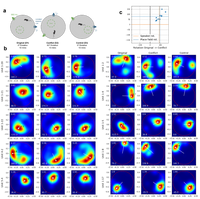
Role of sound-sources for path finding
Upshot: How do auditory objects or cues influence internal spatial representations and the path integration system? How does self-motion impact those representations? Extensive research over the last 50 years identified that to build and update the location of self in the world, both external (allocentric) and internal (idiothetic) information streams are used by the brain. So far, researchers have mainly manipulated visual, tactile (walls, borders) and/or olfactory sensory information to decipher how sensory sources influence internal spatial representations. While auditory cues are highly informative for our orientation and play a crucial role in creating a contextual picture of the current scene, their contributions to the formation of idiothetic maps has been more or less overlooked (O’Keefe, Krupic, 2021). Hence, we aim to test to what extent and how auditory cues shape the internal spatial representations. To this end, we use SIT to perform chronic multi-electrode recordings from the hippocampal area CA1 (place cells), retrosplenial and parietal cortices (head direction cells and egocentric vector representations) in freely-behaving Gerbils.
SITh: Active hearing tests for humans
Our perception is based on active sensing, i.e., the relationship between self-motion and resulting changes to sensory inputs. Yet, traditional experimental paradigms are characterized by delayed reactions to a predetermined stimulus sequence. To increase the engagement of subjects (similar as with non-human animals: Ferreiro, Amaro et al., 2020), we've developed an application to perform auditory discrimiation experiments involving active exploration with humans. With small differences, such as a square arena (instead of circular) and auditory stimuli delivered via bluetooth headphones (instead of free-field), we have essentially replicated the SIT paradigm in humans (SITh). In a recent publication (https://doi.org/10.3389/fnint.2022.892951 ), we show that subjects exhibited similar frequency discrimiation thresholds in SITh as reported in traditional “stationary” forced-choice experiments after performing only 30 trials, highlighting the intuitive nature of SITh. Notably, subjects spontaneously employed a small variety of stereotypical search patterns, and their usage proportions varied between task versions. Moreover, frequency discrimination performance depended on the search pattern used. Overall, we demonstrate that the use of an ecologically driven paradigm is able to reproduce established findings while simultaneously providing rich behavioral data for the description of sensory ethology.

